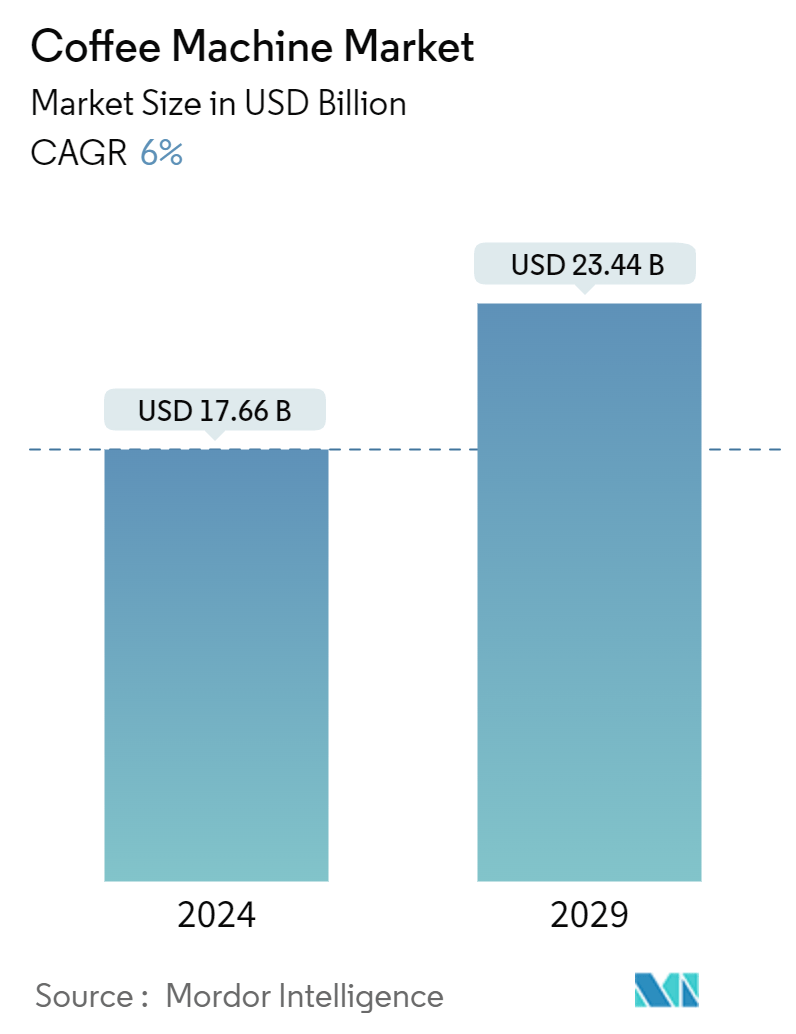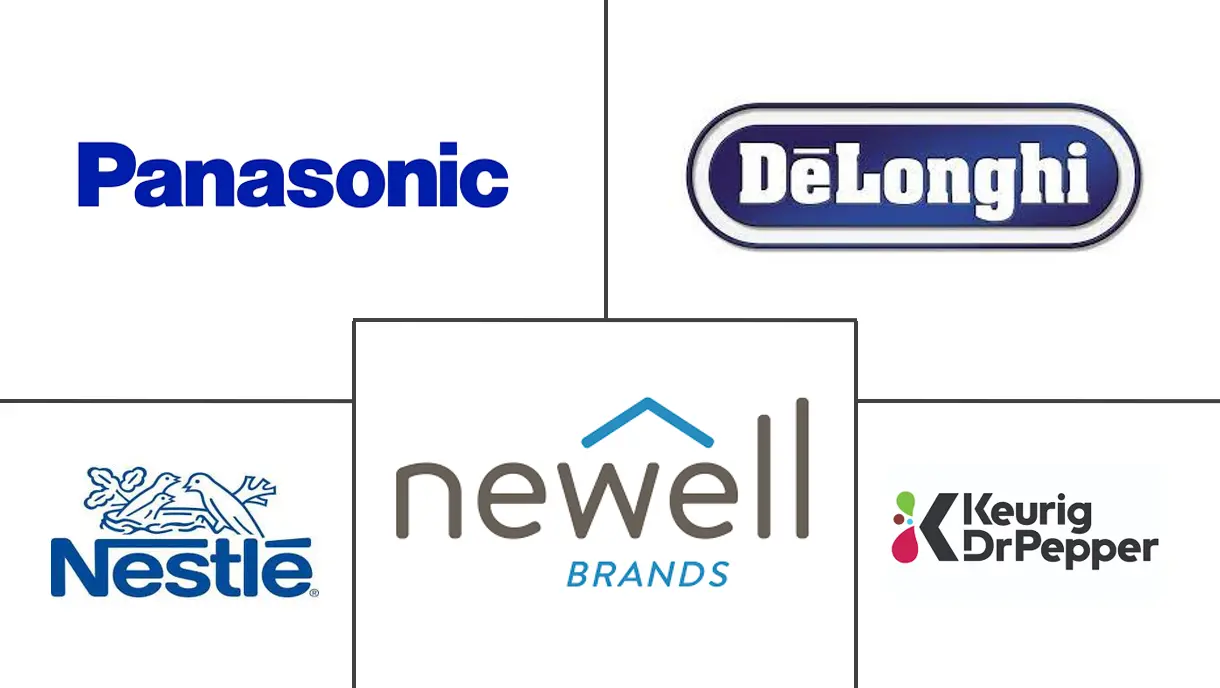Market Size of Coffee Machine Industry

| Study Period | 2020 - 2029 |
| Market Size (2024) | USD 17.66 Billion |
| Market Size (2029) | USD 23.44 Billion |
| CAGR (2024 - 2029) | 6.00 % |
| Fastest Growing Market | Asia-Pacific |
| Largest Market | Europe |
| Market Concentration | Low |
Major Players
*Disclaimer: Major Players sorted in no particular order |
Coffee Machine Market Analysis
The Coffee Machine Market size is estimated at USD 17.66 billion in 2024, and is expected to reach USD 23.44 billion by 2029, growing at a CAGR of 6% during the forecast period (2024-2029).
The coffee industry has witnessed significant evolution in innovations, new product launches, and increasing consumer demand. The rising popularity of instant non-alcoholic beverages like coffee in restaurants and office cafeterias is driving the growth of the coffee machine market. Coffee machines streamline preparing coffee in coffeehouses and office settings, saving time and effort.
Several factors contribute to the growth of instant non-alcoholic beverages such as coffee, including the increasing demand for non-alcoholic drinks among millennials, consumer awareness regarding low-sugar and non-alcoholic options, hectic work schedules, and changing consumer preferences. A recent trend in the global market is the emergence of smart coffee machines with Bluetooth or Wi-Fi connectivity. These smart machines can be controlled via smartphones, allowing users to operate them from anywhere within their homes. However, concerns about the adverse effects of excessive caffeine consumption and high maintenance costs may limit the market's growth.
Coffee Machine Industry Segmentation
Coffee machines use various brewing processes. These machines can vary in complexity and price, offering different brewing methods and features to cater to other preferences.
The coffee machines market is segmented by product type, by operation category, by end user, by distribution channel, and by geography. By product type, the market is segmented into filter coffee machines, capsule or pod coffee machines, traditional espresso machines, bean-to-cup coffee machines, and other product types. By operation category, the market is segmented into semi-automated and fully automated. By end user,, the market is segmented into residential and commercial, By distribution channel, the market is segmented into multi-branded stores, specialty stores, online stores, and other distribution channels, and by geography, the market is segmented into North America, Europe, Asia-Pacific, South America, Middle East, and Africa.
The reports offer the market sizing and forecasts for the coffee machine market in value (USD) for all the above segments.
| By Product Type | |
| Filter Coffee Machines | |
| Capsule or Pod Coffee Machines | |
| Traditional Espresso Machines | |
| Bean-to-cup Coffee Machines | |
| Other Product Types (Dip Coffee Marker, Etc.) |
| By Operation Category | |
| Semi-automated | |
| Fully Automated |
| End User | |
| Residential | |
| Commercial |
| Distribution Channel | |
| Multi-branded Stores | |
| Specialty Stores | |
| Online Stores | |
| Other Distribution Channels (Local Dealers, Etc.) |
| North America | |
| United States | |
| Canada | |
| Mexico | |
| Rest of North America |
| Europe | |
| United Kingdom | |
| Germany | |
| France | |
| Russia | |
| Italy | |
| Spain | |
| Rest of Europe |
| Asia-Pacific | |
| India | |
| China | |
| Japan | |
| Australia | |
| Rest of Asia-Pacific |
| South America | |
| Brazil | |
| Argentina | |
| Rest of South America |
| Middle East and Africa | |
| United Arab Emirates | |
| South Africa | |
| Rest of Middle East and Africa |
Coffee Machine Market Size Summary
The coffee machine market is experiencing robust growth, driven by the increasing demand for instant non-alcoholic beverages like coffee in various settings, including restaurants and office cafeterias. This demand is fueled by changing consumer preferences, such as the rising popularity of low-sugar and non-alcoholic options, particularly among millennials. The market is also witnessing a trend towards smart coffee machines equipped with Bluetooth or Wi-Fi connectivity, allowing users to control them via smartphones. However, concerns regarding excessive caffeine consumption and high maintenance costs may pose challenges to market expansion. The residential segment is gaining traction, with various coffee machines like drip makers, espresso machines, and pod coffee machines becoming popular for their convenience and versatility.
The Asia-Pacific region is emerging as the fastest-growing market, driven by rapid urbanization, a burgeoning middle-income population, and a growing coffee culture. Countries like China, India, and Japan are seeing increased demand for coffee machines due to technological advancements, rising disposable incomes, and a growing number of workplaces. The proliferation of coffee shops and the popularity of capsule systems further contribute to the market's growth in this region. The market is fragmented, with numerous players, including Keurig Dr Pepper Inc., De'Longhi Group, Newell Brands, Nestlé SA, Philips, and Panasonic Corporation, actively innovating and expanding their presence. Recent collaborations and technological advancements, such as those by Keurig Dr. Pepper Inc. and Nestlé S.A., highlight the ongoing efforts to enhance product offerings and supply chain transparency.
Coffee Machine Market Size - Table of Contents
-
1. MARKET DYNAMICS AND INSIGHTS
-
1.1 Market Overview
-
1.2 Market Drivers
-
1.2.1 Demand for Convenience and Time Saving Solution
-
1.2.2 Increase in Consumption of Coffee
-
-
1.3 Market Restraints
-
1.3.1 High Cost of Maintenance
-
1.3.2 Environmental Impact of Single-use Coffee Pods and Capsules
-
-
1.4 Market Oppounities
-
1.4.1 Advancements in Technology to Fuel Market Growth
-
-
1.5 Value Chain Analysis
-
1.6 Industry Attractiveness: Porter's Five Forces Analysis
-
1.6.1 Threat of New Entrants
-
1.6.2 Bargaining Power of Buyers/Consumers
-
1.6.3 Bargaining Power of Suppliers
-
1.6.4 Threat of Substitute Products
-
1.6.5 Intensity of Competitive Rivalry
-
-
1.7 Insights into Technological Advancements in the Industry
-
1.8 Impact of COVID-19 on the Market
-
-
2. MARKET SEGMENTATION
-
2.1 By Product Type
-
2.1.1 Filter Coffee Machines
-
2.1.2 Capsule or Pod Coffee Machines
-
2.1.3 Traditional Espresso Machines
-
2.1.4 Bean-to-cup Coffee Machines
-
2.1.5 Other Product Types (Dip Coffee Marker, Etc.)
-
-
2.2 By Operation Category
-
2.2.1 Semi-automated
-
2.2.2 Fully Automated
-
-
2.3 End User
-
2.3.1 Residential
-
2.3.2 Commercial
-
-
2.4 Distribution Channel
-
2.4.1 Multi-branded Stores
-
2.4.2 Specialty Stores
-
2.4.3 Online Stores
-
2.4.4 Other Distribution Channels (Local Dealers, Etc.)
-
-
2.5 By Geography
-
2.6 North America
-
2.6.1 United States
-
2.6.2 Canada
-
2.6.3 Mexico
-
2.6.4 Rest of North America
-
-
2.7 Europe
-
2.7.1 United Kingdom
-
2.7.2 Germany
-
2.7.3 France
-
2.7.4 Russia
-
2.7.5 Italy
-
2.7.6 Spain
-
2.7.7 Rest of Europe
-
-
2.8 Asia-Pacific
-
2.8.1 India
-
2.8.2 China
-
2.8.3 Japan
-
2.8.4 Australia
-
2.8.5 Rest of Asia-Pacific
-
-
2.9 South America
-
2.9.1 Brazil
-
2.9.2 Argentina
-
2.9.3 Rest of South America
-
-
2.10 Middle East and Africa
-
2.10.1 United Arab Emirates
-
2.10.2 South Africa
-
2.10.3 Rest of Middle East and Africa
-
-
Coffee Machine Market Size FAQs
How big is the Coffee Machine Market?
The Coffee Machine Market size is expected to reach USD 17.66 billion in 2024 and grow at a CAGR of 6% to reach USD 23.44 billion by 2029.
What is the current Coffee Machine Market size?
In 2024, the Coffee Machine Market size is expected to reach USD 17.66 billion.

